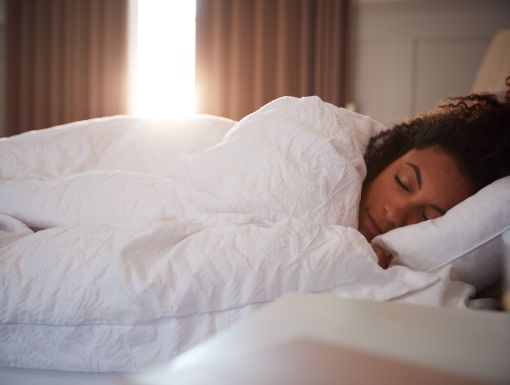
Benefits of Weighted Blankets: Do They Help with Sleep?
Some research suggests that adding a weighted blanket to your sleep routine may help people with anxiety, insomnia and autism get a better night’s rest. But does it work?
What is a weighted blanket?
Weighted blankets are heavier than standard blankets and typically weigh between 5 to 30 pounds. They are designed to apply an even amount of weight and pressure across the body. This is called deep pressure stimulation, which uses firm, controlled pressure to help relax the nervous system and induce a feeling of calm. This can help reduce the fight-or-flight response and help relax the body in preparation for sleep.
What are the benefits of weighted blankets?
The deep pressure stimulation provided by the weighted blanket can help reduce pain, lessen anxiety and help improve moods. You can compare using a weighted blanket to how we swaddle a baby. It helps you feel cozy and can provide a sense of security, which may help you doze off quicker.
Who may benefit from a weighted blanket?
While many people can benefit from a weighted blanket, some research has shown benefits for people with:
- Anxiety – Having anxiety can affect a person’s ability to get and stay asleep. Weighted blankets have been shown to help reduce anxiety symptoms, such as increased heart rates, which can help you sleep. One study found that 63% of people reported lower levels of anxiety after using a weighted blanket.
- Insomnia – Weighted blankets can help ground the body during sleep and produce a calming effect. They can promote relaxation, which can help those with insomnia. A study that looked into insomnia treatment found that participants using the weighted blanket for four weeks reported significantly reduced insomnia severity, better sleep maintenance, a higher daytime activity level, and reduced symptoms of fatigue, depression and anxiety. It also found that participants in the weighted blanket group were almost 26 times more likely to experience less insomnia severity than those not using the weighted blanket.
- Autism – People and children with autism can be overwhelmed by the sensory stimuli of their surroundings. A weighted blanket may help them focus on the pressure instead of other things happening around them. The pressure can help them relax and feel a sense of calm, especially in situations where they may feel overly stimulated. While more research needs to be conducted, some studies have shown that children with autism prefer to sleep with a weighted blanket.
Is there anyone who shouldn’t use a weighted blanket?
Weighted blankets are generally safe, but you should talk with your doctor before incorporating it into your sleep routine, especially if you have medical conditions that affect your respiratory or circulatory health, such as asthma, low blood pressure, type 2 diabetes or claustrophobia. There are some weighted blanket options available for children. However, you should talk to your child’s pediatrician first before incorporating it into their routine. You should never use a weighted blanket with infants or toddlers because they could risk becoming trapped underneath.
How heavy should the weighted blanket be?
Your weight will help determine how heavy your weighted blanket should be. It is recommended to choose a weighted blanket that is about 10% of your body weight. However, preference may vary, so consider how you want to feel when deciding what is best for you.
Can you wash a weighted blanket?
Care instructions vary among weighted blankets. Before washing your weighted blanket, check and follow the instructions on the label. Some weighted blankets may be difficult to wash and may require spot cleaning. How often you wash your weighted blanket will depend on how much you use it, but generally the more frequently you wash, the more likely the blanket will lose its form and durability.
Schedule an appointment with psychiatrist and behavioral health specialist Michael Blanchard, MD.
Learn more about diagnosing sleep disorders.


